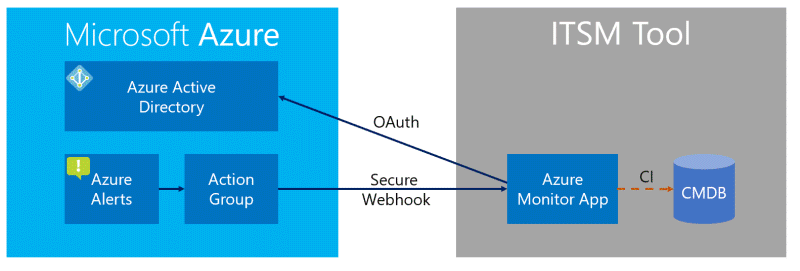Connect Azure to ITSM tools by using Secure Webhook
This article shows you how to configure the connection between your IT Service Management (ITSM) product or service by using Secure Webhook.
Secure Webhook is an updated version of IT Service Management Connector (ITSMC). Both versions allow you to create work items in an ITSM tool when Azure Monitor sends alerts. The functionality includes metric, log search, and activity log alerts.
ITSMC uses username and password credentials. Secure Webhook has stronger authentication because it uses Microsoft Entra ID. Microsoft Entra ID is Microsoft's cloud-based identity and access management service. It helps users sign in and access internal or external resources. Using Microsoft Entra ID with ITSM helps to identify Azure alerts (through the Microsoft Entra application ID) that were sent to the external system.
Secure Webhook architecture
The Secure Webhook architecture introduces the following new capabilities:
- New action group: Alerts are sent to the ITSM tool through the Secure Webhook action group, instead of the ITSM action group that ITSMC uses.
- Microsoft Entra authentication: Authentication occurs through Microsoft Entra ID instead of username and password credentials.
Secure Webhook data flow
The steps of the Secure Webhook data flow are:
Azure Monitor sends an alert that's configured to use Secure Webhook.
The alert payload is sent by a Secure Webhook action to the ITSM tool.
The ITSM application checks with Microsoft Entra ID to determine if the alert is authorized to enter the ITSM tool.
If the alert is authorized, the application:
- Creates a work item (for example, an incident) in the ITSM tool.
- Binds the ID of the configuration item to the customer management database.
Benefits of Secure Webhook
The main benefits of the integration are:
- Better authentication: Microsoft Entra ID provides more secure authentication without the timeouts that commonly occur in ITSMC.
- Alerts resolved in the ITSM tool: Metric alerts implement fired and resolved states. When the condition is met, the alert state is fired. When the condition isn't met anymore, the alert state is resolved. In ITSMC, alerts can't be resolved automatically. With Secure Webhook, the resolved state flows to the ITSM tool, so it's updated automatically.
- Common alert schema: In ITSMC, the schema of the alert payload differs based on the alert type. In Secure Webhook, there's a common schema for all alert types. This common schema contains the configuration item for all alert types. All alert types will be able to bind their configuration item with the customer management database.
Next steps
Feedback
Coming soon: Throughout 2024 we will be phasing out GitHub Issues as the feedback mechanism for content and replacing it with a new feedback system. For more information see: https://aka.ms/ContentUserFeedback.
Submit and view feedback for
